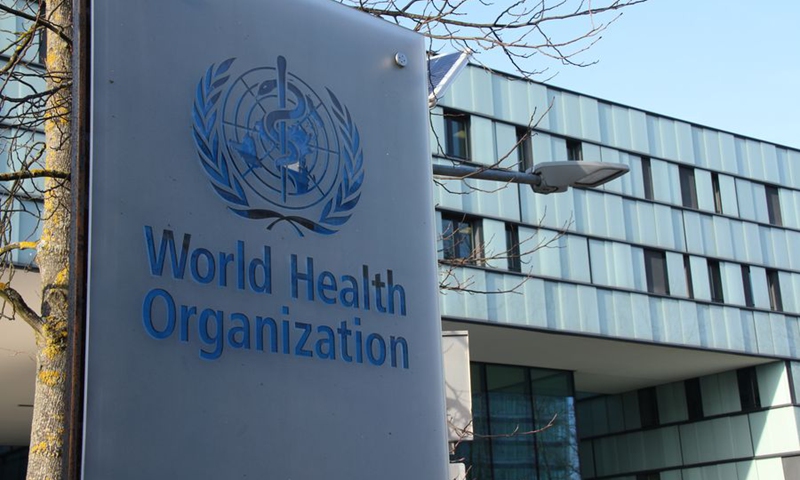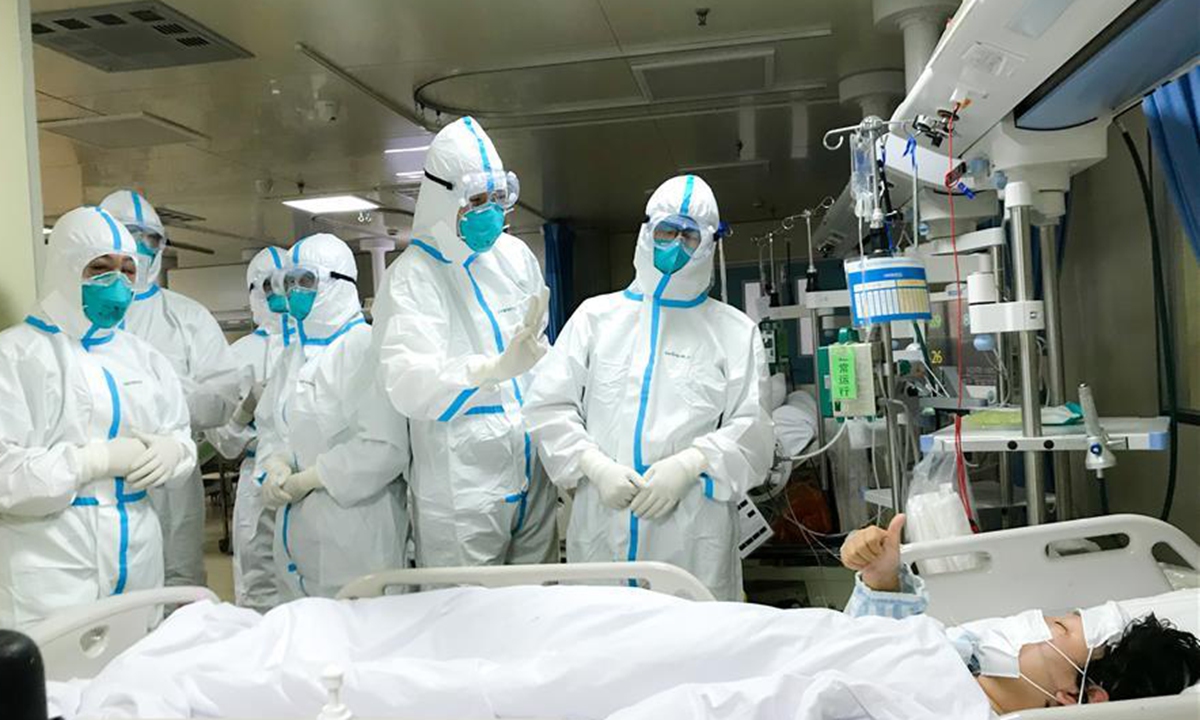China actively publishing, sharing accurate COVID-related data with world

The headquarters of the World Health Organization (WHO) in Geneva, Switzerland.Photo: Xinhua
It takes time to generate COVID-19 data amid caseload surge: epidemiologist
China has conducted multiple technological exchanges with the World Health Organization (WHO), and will continue to support the organization in the global effort to combat COVID-19, the head of China's National Health Commission (NHC) told the head of the WHO over the phone on Saturday, as China on the same day published its data of in-hospital COVID-19 deaths after optimizing the country's COVID-19 response last month.
As data is the pillar of China's COVID-19 response, there is no reason for the country to hide or deliberately under-report such data, said Chinese epidemiologists. They explained it takes time to generate accurate data, and the government is racing against time in its efforts to provide the public with the accurate data, and this reflects its responsible attitude toward public health.
Ma Xiaowei, head of China's NHC, talked over the phonewith WHO Director-General Tedros Adhanom Ghebreyesus on Saturday, exchanging views on the current COVID-19 prevention and control measures.
Ma said that China had shared information with the WHO and other countries since the beginning of the epidemic, was the first to identify the pathogen and share its genetic sequence, and established a mechanism for technical exchanges with the WHO.
Since China took the initiative to optimize and adjust its own epidemic prevention and control policies in light of the current situation, the two sides have conducted many technical exchanges, Ma said, adding that China will continue to support the WHO in the fight against COVID-19.
Tedros expressed appreciation for China's efforts to maintain long-term technical exchanges and share epidemic information and data with the WHO. "WHO appreciates this meeting, as well as the public release of information on the overall situation," the Geneva-based agency said in a statement.
"Chinese officials provided information to WHO and in a press conference on a range of topics, including outpatient clinics, hospitalizations, patients requiring emergency treatment and critical care, and hospital deaths related to COVID-19 infection," the statement continued.
China and the WHO have been in close contact since Chinese health authorities last month optimized its COVID-19 response. Wang Wenbin, a spokesperson of China's Ministry of Foreign Affairs, said on Thursday that China and the international organization held five technical exchanges in the past month.
Recently, the WHO has repeatedly called for China to share more data on its COVID-19 situation to better understand the transmission dynamics of the virus on the ground.
An expert close to the Chinese Center for Disease Control and Prevention (Chinese CDC), who declined to be named, told the Global Times on Sunday that China has always closely monitored its COVID-19 situation, including COVID-related deaths and the emergence of new variants.
After China downgraded its management of COVID-19 from Class A to Class B, the Chinese CDC's information network continued to serve as the main pillar of the whole monitoring system, supported by reports and surveillance data from hospitals, key organizations and key groups, the expert revealed.
The expert said that after China optimized its COVID-19 control, cases began to pile up, thus it is hard to obtain an accurate grasp of the death rate during peak infections. Such assessment can be made only after the infection ebbs away, and the current stage should focus on preventing severe and fatal cases.
Liang Wannian, head of China's COVID-19 response expert panel under the NHC, said on Wednesdaythat rather than focusing on the death toll in China caused by COVID-19, the priority for the world is to get through the impact of the pandemic. He noted that calculating the specific number of deaths caused by COVID-19 is unfeasible for most countries and regions.

Medical team from the PLA Naval Medical University helped Hankou Hospital in Wuhan in January 2020. The photo shows members of the medical team of the PLA Naval Medical University being thanked by a patient at Hankou Hospital in Wuhan, Central China's Hubei Province, on January 27, 2020. Photo: Xinhua
Honest, responsible data
On Saturday, Jiao Yahui, an NHC official, said that a total of 59,938 COVID-related deaths in hospitalswere reported between December 8, 2022 and January 12, 2023.
In an interview with the Global Times on Tuesday, an expert close to the WHO said that there were concerns over the definition of death caused by COVID-19 within that organization, and he revealed that China and the WHO are trying to reconcile this issue and they are working on it.
China has insisted on classifying deaths of patients with a positive nucleic acid test as COVID-19-related deaths, which is in line with the WHO and international standards, Jiao said on Saturday. She clarified that the causes of COVID-19 deaths are twofold: coronavirus infection leading to respiratory failure and death, or underlying diseases interacting with the coronavirus leading to death, Jiao said.
The US Centers for Disease Control noted that deaths are reported as coronavirus disease deaths "when coronavirus disease 2019 or COVID-19 are reported as a cause that contributed to death on the death certificate."
Jiao also said that both the number of infections and figures of severe cases had already reached a tapering point. The number of severe COVID-19 cases reached a peak on January 5, standing at 128,000, according to Jiao, who also noted that the number was down to 105,000 as of January 12 and that 75.3 percent of beds for severe cases were occupied.
The number of visits to China's fever clinics peaked on December 23, 2022, the NHC announced on Saturday. The number totaled 2.87 million that day, according to Jiao.
However, some foreign media still questioned the data released on Saturday, saying that it is underreporting as the data was confined within only hospitals.
The expert close to the Chinese CDC said that China is also getting to grips with the number of COVID-related deaths beyond hospitals, but due to lack of testing or delayed reporting, the calculation may take longer than those compiled by hospitals.
Wu Zunyou, chief epidemiologist at the Chinese CDC, said last week that right after the pandemic broke out in 2020, the center has continued to analyze excess mortality (which was defined by WHO as the difference in the total number of deaths in a crisis compared to those anticipated under normal conditions], and published the results.
He noted that the center is also doing research on excess mortality linked to China's recent exit wave, and will provide information to the public later.
"Data is the pillar that supports our COVID-19 response. China has never stopped or deliberately hidden COVID-19 information from public, [and] the country with vast population needs time and massive, complicated calculations to generate accurate numbers, which shows the government's responsible attitude," said the above-quoted anonymous expert.
Photos
Related Stories
- Posters: China's fight against COVID with solidarity, tenacity and mutual support
- Interview: China's COVID policy adjustment comes at right time: Tanzanian ambassador
- No local Omicron XBB.1.5 infections detected in China so far
- Commentary: COVID restrictions on travelers from China another political farce
- Russia welcomes China's optimization of COVID-19 response
- China enters a new stage of COVID-19 response
Copyright © 2023 People's Daily Online. All Rights Reserved.









